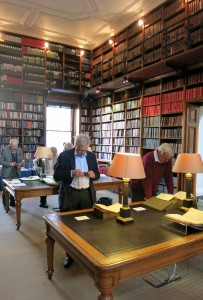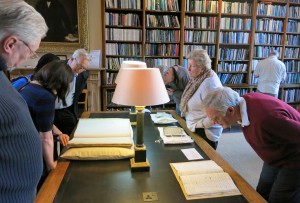January 23, 2015
Flamsteed History Group Visit to the RAS Library
Report by: Mike Dryland
Brian Blake kindly arranged for us to visit the impressive Royal Astronomical Society Library where we were met by librarian Sian Prosser. Sian gave us a short introductory talk about the RAS and its activities.
The RAS was founded in 1820, partly in response to the tyrannical rule of Sir Joseph Banks over the Royal Society at the time. Banks attempted to sabotage the founding and discouraged the first RAS President designate, the Duke of Somerset, from standing, but Sir William Herschel, discoverer of the planet Uranus and then the Grand Old Man of British astronomy, agreed to become President (although he never took the chair at a meeting). A Royal Charter was granted by William IV in 1831. After meeting in various locations the Society moved to its present home in Burlington House in 1874. The list of RAS Presidents is a roll-of-honour of British astronomy including such luminaries as John Couch Adams, George Airy, Jocelyn Bell Burnell, Arthur Eddington, and John Herschel.
The RAS Library collection was started at the outset and has grown into around 35,000 bound items and a large collection of manuscripts, journals and unbound pamphlets. One of the most important parts is the Herschel Archive. Sian had laid out a selection of spectacular treasures from the library and gave us a few words about each.
For many of us the jewel in the crown was William Herschel’s manuscript journal open at the page in March 1781 when he first recorded his observation of Uranus which he thought was “a Nebulous star or perhaps a comet”. It was soon identified by the Astronomer Royal, Nevil Maskelyne, and others as a newly discovered planet. Equally thrilling was a copy of John Flamsteed’s Atlas Coelestis which belonged to the Herschels and is annotated in Caroline Herschel’s own hand with details of their observations.
Also on view for us were two works by Isaac Newton – a first edition in English of the Principia, and an early edition of Opticks. There too was a copy of Edmond Halley’s treatise on Comets in which he predicted the return of the comet of 1607 and 1682. Now known as ‘Halley’s Comet’, it was, of course, re-sighted in 1758.
The earliest documents on show were a copy of the Alfonsine tables, and also an early edition of Galileo’s Siderius Nuncius (Starry Message) in which he reported his telescope observations (maybe the first astronomical observations made using the telescope) including evidence for the heliocentric model of the solar system.
In the library’s display cases were a selection of items relating to solar eclipses. Very interestingly they included Francis Baily’s original description of Baily’s Beads, an effect caused by sunlight shining through lunar mountain peaks during a total eclipse. On display also were original photographic prints from Eddington’s expedition to observe the 1919 solar eclipse. The photographs were analysed to measure the apparent displacement of star positions close to the Sun, then taken as proof of Einstein’s General Theory of Relativity. We stared at the prints but I was unable to identify any stars at all, maybe some specks of dust! Eddington’s ‘proof’ was controversial but fortunately for Einstein the Theory of Relativity has since been shown to be correct in many different experiments (give or take black holes..).
Thanks again to Sian Prosser and Brian Blake for arranging such an excellent hour among these fascinating and stimulating objects.
Mike Dryland
Pictures from the visit (by Mike Dryland):
Posted under: Flamsteed, History of Astronomy, Meeting Report, Society Trip








You must be logged in to post a comment.